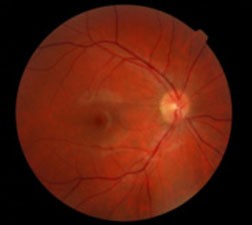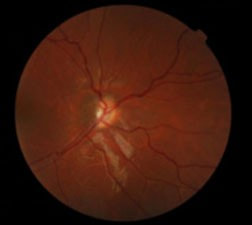Optic Nerve HypoplasiaHow is optic nerve hypoplasia diagnosed?
The diagnosis of ONH is typically made by the appearance of small/pale optic nerve during a dilated eye exam. There can be a surrounding halo of yellow tissue bordered by a ring which is known as the double-ring sign. The retinal vessels may appear tortuous or have fewer branches, and special imaging of the retina (optical coherence tomography OCT) may reveal mild thinning in the retina. It is difficult to predict what the visual acuity will be based only on the optic nerve appearance. What causes optic nerve hypoplasia?
Most cases of ONH have no clearly identifiable cause. There are no known racial or socioeconomic factors in the development of ONH, nor is there a known association with exposure to pesticides. Although ONH has been associated with maternal drug use, fetal alcohol syndrome, and the use of some medications during pregnancy such as phenytoin and quinine, these causes are very rare. Gene mutations are also rare. Some risk factors are the mother’s first pregnancy and young maternal age, but we don’t know why these can cause ONH. Are there other conditions which may be confused with optic never hypoplasia?
Other conditions which may mimic ONH are optic nerve atrophy, a tilted optic nerve, or the pallor of Leber congenital amaurosis. These conditions have a normal size optic nerve. What visual problems are associated with optic nerve hypoplasia?
Vision impairment from ONH ranges from mild (20/20) to severe (blindness) and may affect one or both eyes. Nystagmus (shaking of the eyes) may be seen with both unilateral and bilateral cases. Additional loss of vision from amblyopia may develop if only one eye has OHN. The incidence of strabismus is also increased with ONH. Is optic nerve hypoplasia associated with non-visual problems?
Optic nerve hypoplasia can be associated with central nervous system (CNS) malformations which put the patient at risk for other problems, including seizure disorder and developmental delay. Certain malformation on brain magnetic resonance imaging (MRI) are highly predictive of associated hormone and developmental abnormalities such as posterior pituitary ectopia or cerebral hemispheric abnormalities. Significant hormone deficiencies occur in 15% of children with OHN, but mild hormone deficiencies occur in the majority of patients regardless of normal MRI findings. What tests should be done for children with optic nerve hypoplasia?
A MRI scan is indicated for all children with optic nerve hypoplasia. Evaluation by an endocrinologist should be mandatory for all patients under five years of age. Does optic nerve hypoplasia get worse over time?
In general, ONH is a stable and nonprogressive condition which does not deteriorate. Vision may improve slightly and nystagmus may decrease over time. Is there any treatment for optic nerve hypoplasia?
There is no medical or surgical treatment for ONH. However, occlusion of the better seeing eye may improve vision associated amblyopia if present. Children with significant vision loss in both eyes may benefit from early supportive attention by low vision specialists, including an Early Intervention Teacher of the Visually Impaired. Stem cell treatment has not been shown to be effective for ONH. Where can I find more information regarding septo-optic dysplasia?
|
A Shared Vision: Partners in Pediatric Blindness & Visual Impairment
EIN 81-4227664


